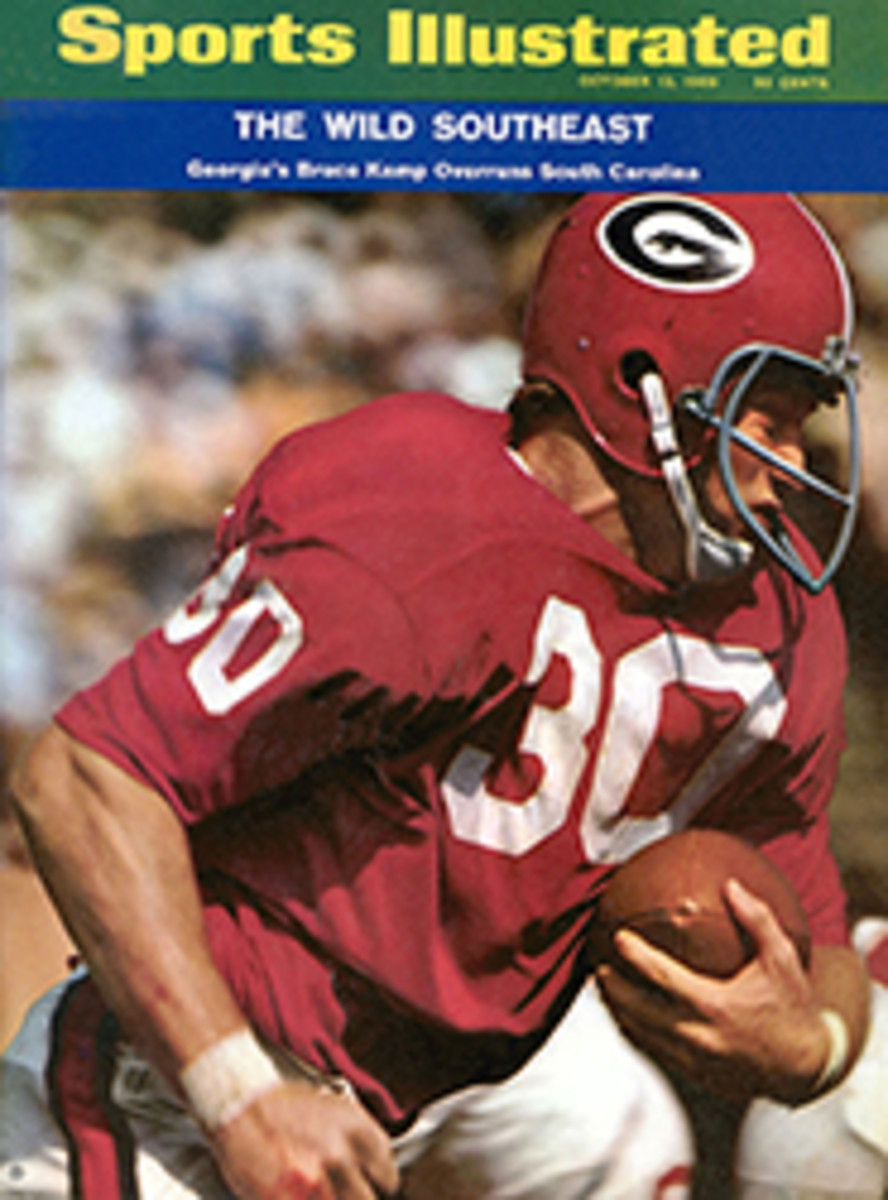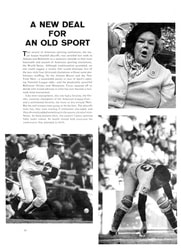
A small school, but you can learn to hate it
Crete, Neb. (pop. 3,546) is just down the road from Sprague-Martell (pop. 75), 11 miles east of Dorchester (pop. 460), and the Gateway to Wilber (pop. 1,358) and the South. It is a Norman Rockwell town cut out of the cornfields, where the big studs still polish their machines during the week then race them on Saturday; where there is but one movie house, one motel, two traffic lights, three caution lights and a train platform between two grain silos. There are no parking meters, and the only full-time dry cleaner went out of business last year when a train ran through his shop. Girls wear skirts to the knees. It's a wholesome town.
At the corner of 13th and Main Street in Crete is the Sportsman Bar and Grill. Each night in the last booth on the left Harvey Kennedy sits over a cup of coffee. Last weekend and the weekend before that and the two weekends before that, Harvey Kennedy, a maintenance man at the Alpo plant back up Route 33, has bet $100 on the Doane College football team. This wouldn't seem like a daring bet, since Doane College, Crete, Neb., has not lost in its last 33 games and presently has the longest unbeaten streak in college football. Except that Harvey Kennedy, you see, gives 40 points a game.
Now that's not really a bad bet. This year Harvey has just about broken even. If he had bet last year, when Doane went 10-0 and finished seventh in the NAIA small-college ratings, he would have won $200. And if he had been a bit conservative and had given only 30 points, he would have won $600. Doane not only wins, it wins big.
That Doane, with an enrollment of 738 (492 boys), should become a football power is as surprising as if Ohio State gave up the game. The school itself was founded 97 years ago and, though it started playing football in 1895, never, never before has there been anything like this. There have been celebrities at the school, true. Only last year Tom Mangelsen, the National Goose Calling Champion, graduated from Doane. Before that there was Wendell Adams, the creator of the "Winston tastes good" jingle. And before that there was the late Robert Taylor, who spent two years at Doane before following his drama teacher to Pomona College. Later, after gaining fame, he returned to receive an honorary degree.
Doane's rise closely paralleled its transition from the comfortably traditional to the hopefully experimental. "Three years ago we decided we had to change," says Charles Hein, the school's publicity director. "We knew we couldn't exist as a college with just 350 kids from Nebraska. We decided to try and create a microcosm of the real world." Until then Doane had been nothing more than the clean-shaven and the short-cut, the sons and daughters of the Midwest. Now there are students from 36 states and 11 foreign countries. There are blacks. There are even, as they call them, hippies. ("Why, those people," one student exclaimed. "One night one of them was just sitting in the pine tree in front of the student center playing his flute.") But still there have never been any riots, not even a demonstration. There was a little uneasiness last spring when Charlie Washington and Ernest Chambers, two black leaders from Omaha, spoke at the school. But even that didn't produce any demands.
The only changes caused by the move into the '60s have been small, but typical. This year, for the first time, the school used IBM cards for registration and, despite the resulting confusion, they are here to stay. Also for the first time students have I.D. numbers. And, unbeknownst to the administration, some enterprising capitalists are now importing stag films from New York and showing them off campus.
But the most noticeable changes have come in football. "It used to be that people were happy any time we won a game," says the head coach, Al Papik. He smiles. "But now because we won by only eight points last week I got three letters asking me what happened."
Such spoiled fans—and such winning ways—result from a decision Papik made six years ago. His career record was then a remarkably mediocre 36-36-6, and he had just suffered through a 3-6 season. "I figured that if I was going to keep coaching I was going to do it right," he says, "and if not I was going to get out. So I subscribed to two Chicago newspapers, watched for boys who made any type of all-city or all-suburban team, then sent them letters explaining our type of situation and seeing if they were interested in us. Before it was over we had sent out some 1,600 letters." And two years later there were 27 Chicago area players at Doane.
But the real jackpot came from Port Arthur, Texas. Paul Broussard, a halfback who had moved from Rantoul, Ill. to Port Arthur, contacted Papik and asked if he could come to Doane. Papik said yes and had his first recruit from Texas, plus a contact in Broussard's high school, Spanish Teacher Clayton Clark. Today five of Doane's starters are from Port Arthur, including the team's two outstanding players, Quarterback Larry Green and Halfback Mike Sallier.
They call Papik The Fox, which fits; he has succeeded under annoying restraints. The school only gives special-ability grants, none worth more than $1,000, and athletics shares these with drama, music and art. (While the football team was extending its streak to 32, the choir head was in Chicago and the art head was in Boston—both recruiting.) The athletic budget does not allow for extensive travel, so there is no chance for a wider or more rigorous schedule, most of the games taking place in Nebraska or neighboring states. The players get clean underwear at the beginning of each week, but not again until game day ("They stand up by then," one player says). Papik is allowed only 400 feet of film per game, which means Doane has movies of only the first half of each game. And now because of the winning streak, there is even talk of Doane overemphasizing football. "That's what comes with success," says Papik. "But if I'd lost 30 in a row the pressure would be greater."
Right now, for him, there is pressure enough. "The players don't think about the streak," says Green, "but I think the coaches are a little uptight about it." Papik is an excitable man. Three weeks ago when Green was hurt, he spent several nights pacing the kitchen, drinking orange juice. And two weeks ago when Doane fell behind at halftime for the first time in the streak, he sent in a nonexistent play that resulted in Chaplinesque comedy in the backfield. "Yes, I guess there is more stress and strain today," Papik says. "My wife just hopes I get out before we lose."
It shouldn't be this year. Doane has already won its first four games, last week crushing Midland 40-16. Green and Sallier, the nation's leading college-division rusher, produce plenty of offense in Papik's simple sweep-trap-counter style of play; Louis Cooper (6'8", 270) and Kevin Hunt (6'5", 250) are among the eight players back from a defense that allowed only 64 points in 10 games last year. "We have solid players and a few highly skilled individuals," Papik says, "and that makes the difference on our level."
That should be enough for any coach. But Papik does not take any chances. There is a sign in the coach's office that reads, BLESS THIS HOUSE, OH LORD WE PRAY. Handwritten underneath is a more practical plea: AND HELP US WIN EVERY TIME WE PLAY.
LITTLE DOANE THE NATION'S BIGGEST WINNER
1965
Colorado College 24-14
Graceland 34-14
1966
Colorado College 20-14
Tarkio 26-0
Hastings 16-7
Nebraska Wesleyan 6-0
St. Mary (Kans.) 27-6
Peru State 48-7
Concordia (Neb.) 20-20
Graceland 54-7
1967
Colorado College 33-7
Tarkio 57-0
Hastings 21-7
Nebraska Wesleyan 49-7
St. Mary (Kans.) 69-25
Peru State 38-0
Concordia (Neb.) 34-7
Graceland 49-23
Wm. Jewell 14-14
1968
Dana 34-0
Concordia (Neb.) 26-12
Tarkio 61-6
Midland 59-13
SW Minnesota 55-7
Hastings 48-13
Dakota Wesleyan 54-0
Nebraska Wesleyan 77-6
Graceland 62-7
Central Mo. 10-0
1969
Dana 41-0
Concordia (Neb.) 48-14
Tarkio 35-27
Midland 40-16

